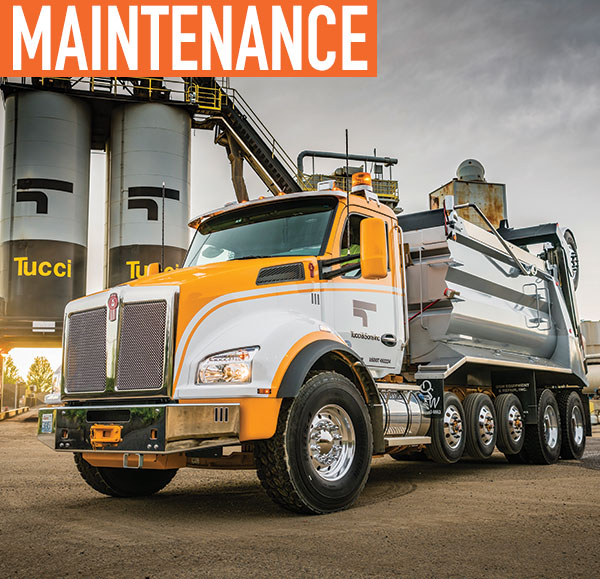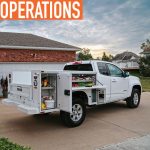Most of today’s large, over-the-road vocational vehicles use air brake systems to provide vehicle braking, as opposed to passenger cars, which use hydraulic braking. Air brake systems have proven to be quite reliable and capable of providing the brake forces required in order to safely decelerate and stop large vehicles in both on-road and off-road applications. That being said, there are specific maintenance and inspection requirements for air brake systems that must be regularly and properly completed, in order to maintain the vehicle’s brake system integrity and overall braking capability.
INSPECTION OVERSIGHT
Industry and the government have long recognized the need for commercial vehicle air brake maintenance and inspections. Fleet owners are required to conduct a pre-trip inspection of a vehicle’s brakes before daily operation.

While this approach sounds logical and effective, in reality, proper brake maintenance and adjustment is a common and recurring issue in the commercial vehicle industry. There are several reasons that contribute to this problem as acknowledged by government reports and inspection data:
- Very few fleet operators conduct a pre-trip brake inspection of their vehicles before placing them into daily service, because the inspection takes time, the procedure requires physically inspecting the vehicles’ brakes by crawling under the vehicle, and a pre-trip brake inspection typically requires two persons in order to be done properly.
- Air disc brakes (recently introduced to the North American market), are virtually impossible to visually inspect for proper operation.
- There is often improper air brake system maintenance due to a lack of qualified mechanics and a general need to reduce operating and maintenance costs wherever possible.
OPERATION AND ADJUSTMENT
It is well known that proper commercial vehicle air brake operation and adjustment is essential in order to ensure full vehicle braking capability. If, for example, the vehicle is equipped with six brakes (wheel ends), and if some or all of these brakes are inoperative (or out of adjustment) then vehicle stopping distances increase based on the quantity and severity of the inoperative or out of adjustment brake conditions.
A feature of commercial air brake systems is that there is no direct “feedback” from the driver’s air brake pedal, and the overall operation of the air brakes on a vehicle. This is because, unlike automotive hydraulic brakes, there is no direct mechanical link between the vehicle air brake pedal and the air brakes at each wheel. Thus, the feedback the driver receives from the brake pedal on a commercial air brake vehicle is the same no matter if the brakes are properly operating, or if they happen to have a serious mechanical issue.
In addition, since most daily brake applications on a commercial vehicle occur at very low brake pressures, the driver typically has no indication that his brakes are inoperative or out of adjustment until they are needed in a panic situation. During a panic stop, suddenly the vehicle brake system is asked to respond, and only at this time does it become evident that some or all of the brakes on the vehicle are out of adjustment or defective.

Figure 1
If the vehicle’s brakes are properly operating, there should be a fairly linear relationship between brake force being applied by the driver and the subsequent vehicle deceleration. If the vehicle’s brakes are not fully operative or are out of adjustment, then this relationship is not linear and stopping distances can radically increase (especially in a panic stop situation as noted above). This effect is shown in Figure 1.
This condition can result in vehicle instability and excessive stopping distances leading to increased risks and the subsequent severity of a collision.
BRAKE DEFECTS
Scientific study, as well as forensic accident investigations by National Transportation Safety Board (NTSB), has well documented the link between vehicle brake defects and accident causation and severity.
A recent study by the University of Michigan Transportation Research Institute (UMTRI) scientifically analyzed data from of the Large Truck Crash Causation Study (LTCCS) conducted by FMCSA and NHTSA during 2001 to 2003. This data set is the largest and most well-known study conducted involving commercial vehicle accidents and their causation. By carefully analyzing the data from this study, UMTRI proved that the only vehicle mechanical defect that can be directly linked to accident causation is brake defects.
SAFETY TECHNOLOGIES
Advanced Safety Technologies, such as ABS, collision avoidance, roll stability, and vehicle stability are all examples of new technologies that increase vehicle safety, and can ultimately reduce collisions and their severity. That being said, it is often overlooked that these advanced safety technologies ultimately rely on properly adjusted and operating foundation brakes in order to be effective. The Safety Technology Pyramid shown in Figure 2 illustrates the relationships and dependencies of these various safety technologies.

Figure 2
It can be seen from the Safety Technology Pyramid and the subsequent interaction of the various safety technologies, that all depend upon proper brake adjustment in order to be effective. For example, the ABS system cannot intervene if a wheel is unable to achieve lock-up, and the vehicle stability system is unable to properly intervene if the brakes cannot fully or properly apply during a vehicle maneuver. This makes it critical that air brake operation is closely monitored, and foundation brake issues corrected, if these dependent technologies are to perform at their full potential. Real-time electric monitoring (such as MGM’s patented e-STROKE technology) of air brakes can provide early warning of pending brake system issues, thus allowing foundation brake problems to be addressed before the foundation brake system is called upon to intervene by other advanced safety technologies in a dangerous driving situation.
FOR MORE INFORMATION
This article was contributed by MGM Brakes. Find out more about MGM Brakes products and services, visit www.mgmbrakes.com.
_______________________________________________________________________
MODERN WORKTRUCK SOLUTIONS: MARCH 2017 ISSUE
Did you enjoy this article?
Subscribe to the FREE Digital Edition of Modern WorkTruck Solutions magazine.
![]()




